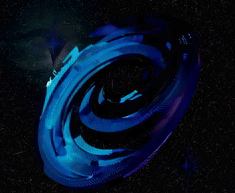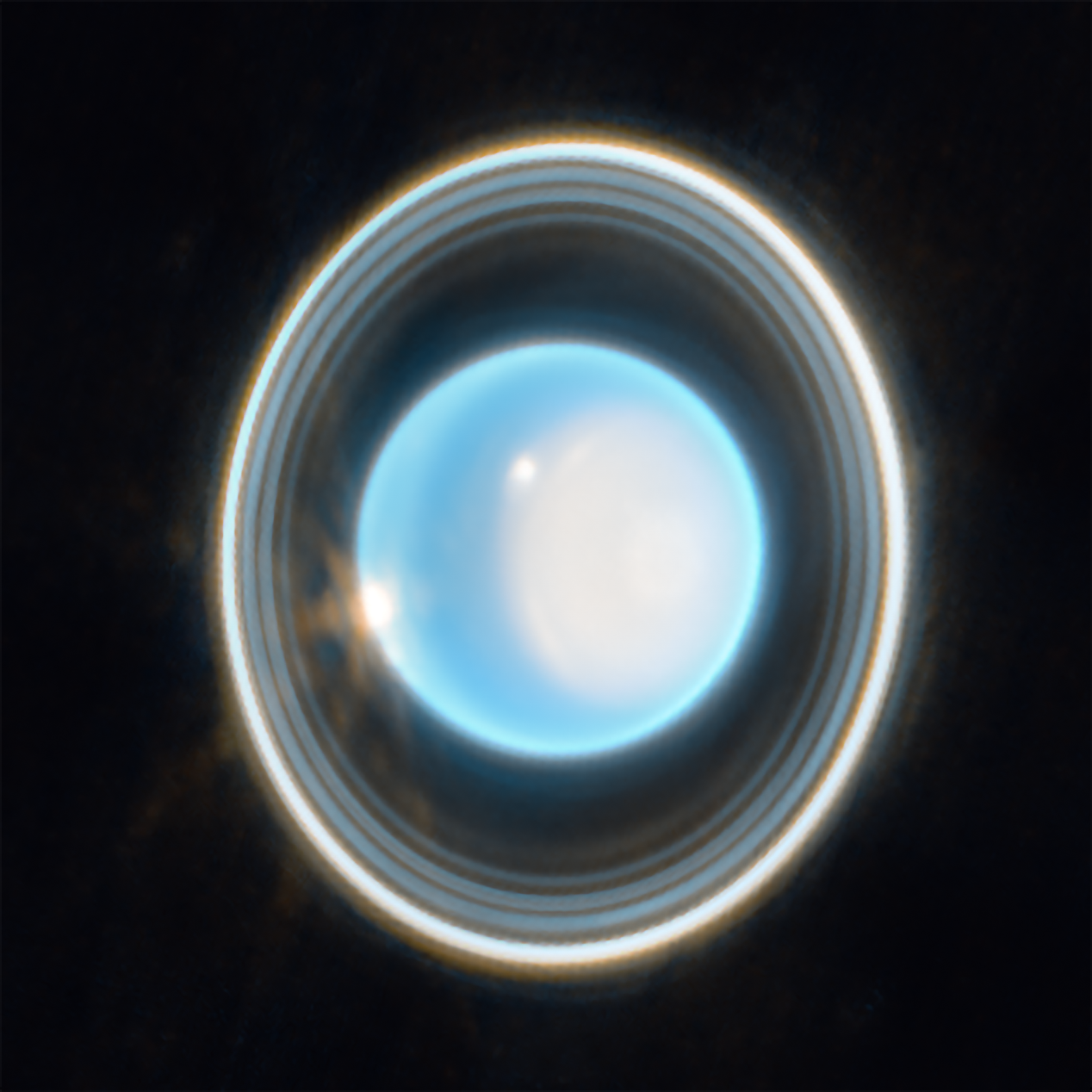Physical Properties, Atmosphere, Rings, and Moons
Uranus is one of the most fascinating environments in our Solar System, full of dark mysteries, intrigue, and undoubtedly novel vacuum physics that we will learn about as we send probes and explore the outer regions of our Solar System. The most interesting aspects of Uranus are its retrograde orbit and tilt, it lays on its side likely from a collision long ago. It has shepherd moons similar to Saturn, and it is the coldest planet in the solar system, even though Neptune is almost twice as far from the Sun!
Elliot’s Open Source Uranus Simulator (live on Github)
1. Planetary Characteristics
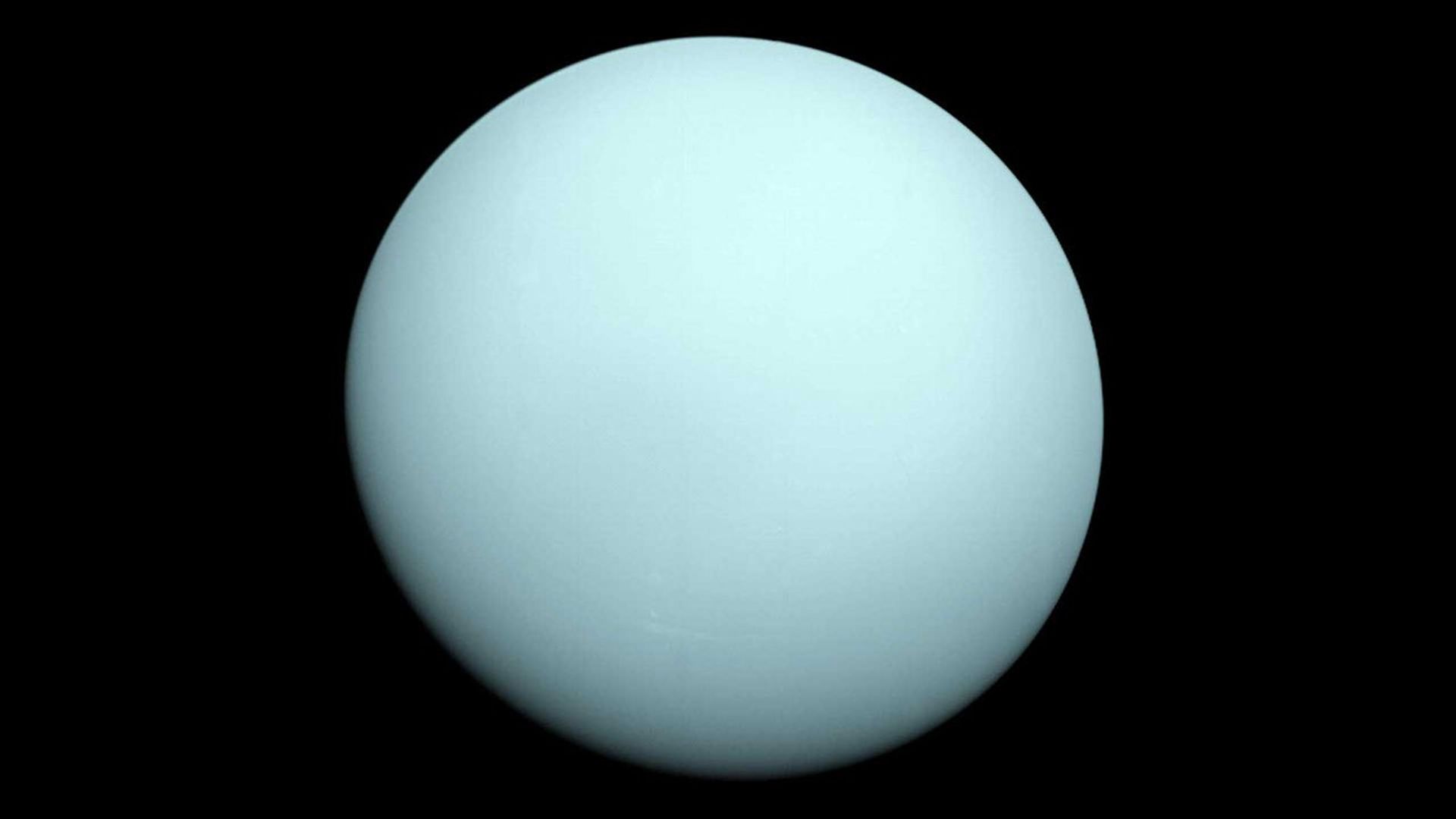
- Equatorial Radius: 25,559 km (4.0 Earth radii)
- Polar Radius: 24,973 km (slightly flattened)
- Oblateness: 0.023
- Mass: 8.681 × 10^25 kg (14.5 Earth masses)
- Mean Density: 1.27 g/cm³
- Surface Gravity: 8.87 m/s² (0.91 g)
Rotation & Tilt
- Day Length: 17.24 hours (retrograde)
- Axial Tilt: 97.77° (rotates nearly sideways)
Orbit
- Semi-major Axis: 19.19 AU (2.87 billion km)
- Orbital Period: 84 years
- Eccentricity: 0.0472
- Inclination: 0.77°
- Velocity: 6.8 km/s
2. Uranus’ Atmosphere
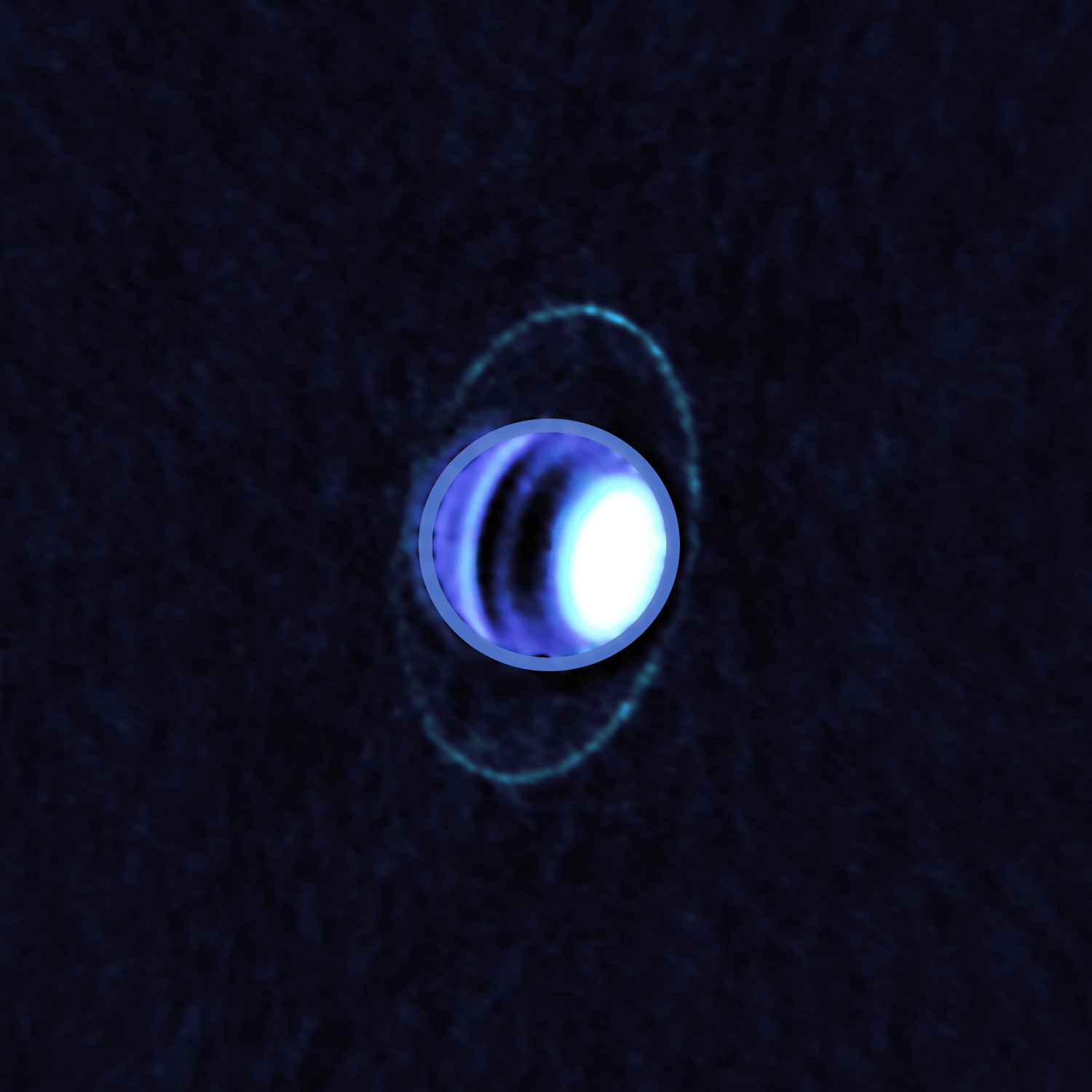
Composition
- Hydrogen: ~82%
- Helium: ~15%
- Methane: ~2.3%
- Traces: ethane, acetylene, water vapor, ammonia, hydrogen sulfide
Temperatures
- Coldest Atmosphere: 49 K (-224°C)
- At 1 bar: 76 K (-197°C)
- Upper Thermosphere: up to 577°C
Appearance & Clouds
- Blue-green hue from methane absorption
- Cloud Layers: methane (~1.2 bar), hydrogen sulfide/ammonia (3–10 bar), ammonium hydrosulfide (20–40 bar), deep water clouds (>50 bar)
Winds
- Max Speed: 900 km/h (560 mph)
- Flow: retrograde at equator, prograde near poles
3. Uranus’ Rings: Structure and Key Facts
Overview
- Total Rings: 13 known
- Discovery: 1977, via stellar occultation
- Composition: Dark, carbon-rich particles (coal-like), ranging from 20 cm to 20 m across
- Reflectivity (albedo): <5% (extremely dark)
Inner to Outer Rings
- ζ (1986U2R) – ~38,000 km radius, broad, dusty
- 6 Ring – ~41,837 km, narrow (<10 km wide)
- 5 Ring – ~42,234 km, narrow
- 4 Ring – ~42,571 km, narrow
- α (Alpha) – ~44,718 km, 4–10 km wide
- β (Beta) – ~45,661 km, 5–11 km wide
- η (Eta) – ~47,175 km, 1–4 km wide
- γ (Gamma) – ~47,627 km, 1–4 km wide
- δ (Delta) – ~48,303 km, 3–7 km wide
- λ (Lambda) – ~50,024 km, 1–2 km wide, dusty
- ε (Epsilon) – ~51,149 km, 20–96 km wide; brightest and densest ring
Outer Rings
- ν (Nu) – 66,100–69,900 km, ~3,800 km wide
- μ (Mu) – 86,000–103,000 km, ~17,000 km wide, outermost
The Epsilon Ring
- Most massive ring
- Width varies: 20–96 km
- Shepherd Moons: Cordelia (inner edge) and Ophelia (outer edge)
- Contributes two-thirds of all reflected light in the Uranian ring system
Moons of Uranus: Major Satellites and New Discoveries
Overview
Uranus has one of the most diverse and fascinating moon systems in the Solar System — 28 confirmed moons (as of 2025). They range from small, irregular outer moons to large icy inner worlds.
| Moon | Group | Diameter_km | SemiMajorAxis_km |
| Titania | Major | 1,576.80 | 436,298 |
| Oberon | Major | 1,522.80 | 583,511 |
| Umbriel | Major | 1,169.4 | 265,986 |
| Ariel | Major | 1,157.8 | 190,929 |
| Miranda | Major | 471.6 | 129,846 |
| Puck | Inner | 162 | 86,004 |
| Sycorax | Irregular | 157 | 12,193,200 |
| Portia | Inner | 135 | 66,100 |
| Juliet | Inner | 94 | 64,400 |
| Belinda | Inner | 90 | 75,300 |
| Cressida | Inner | 80 | 61,800 |
| Rosalind | Inner | 72 | 69,900 |
| Desdemona | Inner | 64 | 62,700 |
| Bianca | Inner | 51 | 59,200 |
| Prospero | Irregular | 50 | 16,221,000 |
| Setebos | Irregular | 47 | 17,519,800 |
| Ophelia | Inner | 43 | 53,800 |
| Caliban | Irregular | 42 | 7,167,000 |
| Cordelia | Inner | 40 | 49,800 |
| Stephano | Irregular | 32 | 7,951,400 |
| Perdita | Inner | 30 | 76,400 |
| Francisco | Irregular | 22 | 4,275,700 |
| Ferdinand | Irregular | 21 | 20,421,400 |
| Margaret | Irregular (prograde) | 20 | 14,425,000 |
| Cupid | Inner | 18 | 74,400 |
| Mab | Inner | 18 | 97,700 |
| Trinculo | Irregular | 18 | 8,502,600 |
| S/2025 U 1 | Inner | 9 | 56,250 |
| S/2023 U 1 | Irregular | 8 | 7,976,600 |
- Total Known Moons: 28+ (as of 2025)
- Largest Moons: Titania, Oberon, Umbriel, Ariel, Miranda
- Naming Theme: Characters from Shakespeare and Alexander Pope
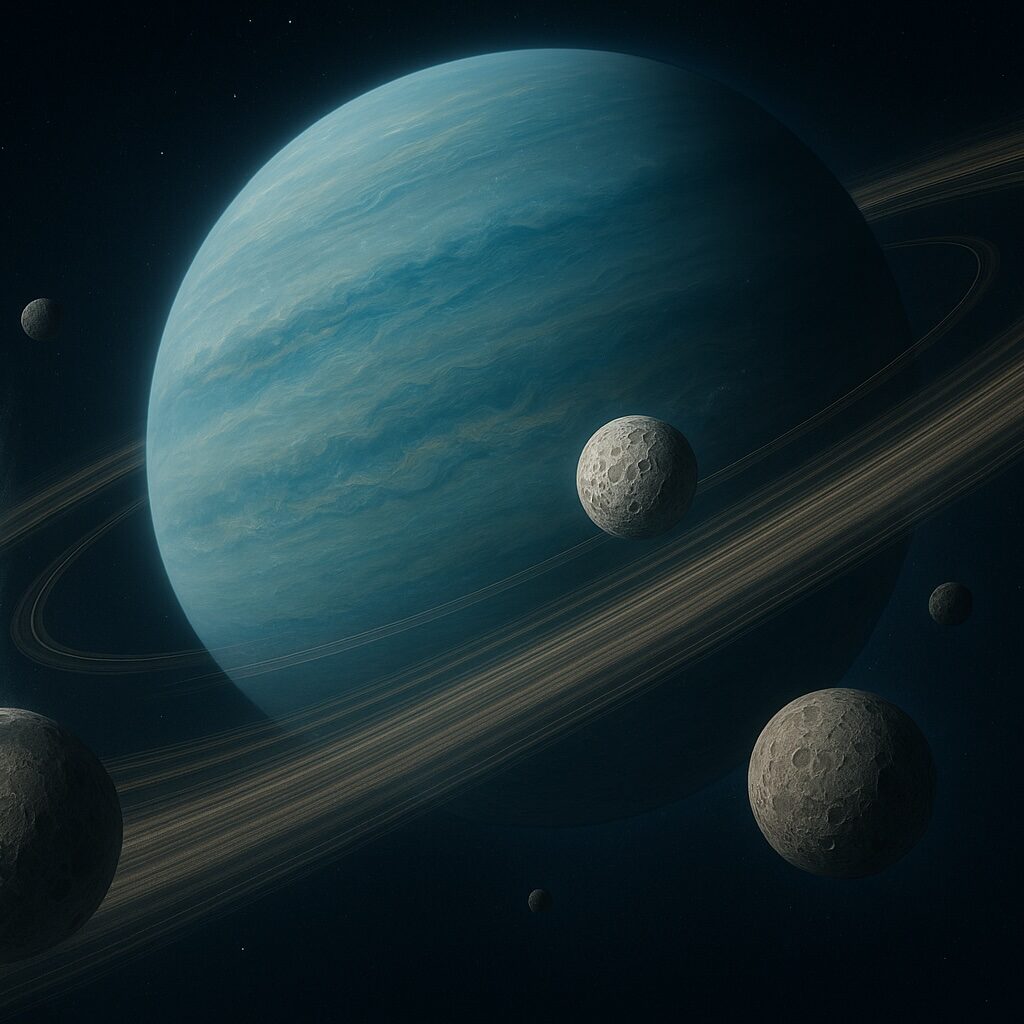
The Five Major Moons
1. Titania
~ Largest Moon of Uranus
- Radius: 788.9 km
- Semi-major Axis: 436,300 km (17.1 Uranus radii)
- Orbital Period: 8.7 days
- Density: 1.71 g/cm³
- Features: Canyon systems, fault lines, possible subsurface ocean
2. Oberon
- Radius: 761.4 km
- Semi-major Axis: 583,500 km (22.8 RU)
- Orbital Period: 13.5 days
- Density: 1.63 g/cm³
- Features: Oldest, most cratered surface; reddish tint
3. Umbriel
- Radius: 584.7 km
- Semi-major Axis: 266,000 km (10.4 RU)
- Orbital Period: 4.1 days
- Density: 1.40 g/cm³
- Features: Darkest moon, heavily cratered, oldest terrain
4. Ariel
- Radius: 578.9 km
- Semi-major Axis: 190,900 km (7.5 RU)
- Orbital Period: 2.5 days
- Density: 1.59 g/cm³
- Features: Brightest moon, geologically young, surface canyons
5. Miranda
- Radius: 235.8 km
- Semi-major Axis: 129,900 km (5.1 RU)
- Orbital Period: 1.4 days
- Density: 1.20 g/cm³
- Features: Verona Rupes (20 km cliff), “coronae” (unique polygonal features), extreme surface diversity
Smaller Inner Moons
- Cordelia & Ophelia: Shepherd moons of the Epsilon Ring
- Bianca, Cressida, Desdemona, Juliet, Portia, Rosalind, Belinda, Puck: Small, irregular moons close to Uranus
Outer Irregular Moons
- Caliban, Sycorax, Prospero, Setebos, Stephano, Trinculo, Francisco, Ferdinand, Margaret, Mab, Cupid, Perdita
- These are captured objects with eccentric and inclined orbits, mostly discovered in the 1990s–2000s.
Recent Discoveries
- S/2023 U1: A tiny, faint moon discovered in 2023, one of the most recent Uranian moon detections.
- Ongoing observations (Hubble, ground-based telescopes) suggest more small moons are waiting to be confirmed.
Key Facts
- Most moons are a mix of ice and rock.
- Several may host subsurface oceans (Titania, Oberon, Ariel).
- Moons interact with Uranus’ rings and magnetosphere, shaping its environment.
Uranus’ Magnetosphere: Tilted, Twisted, and Unique
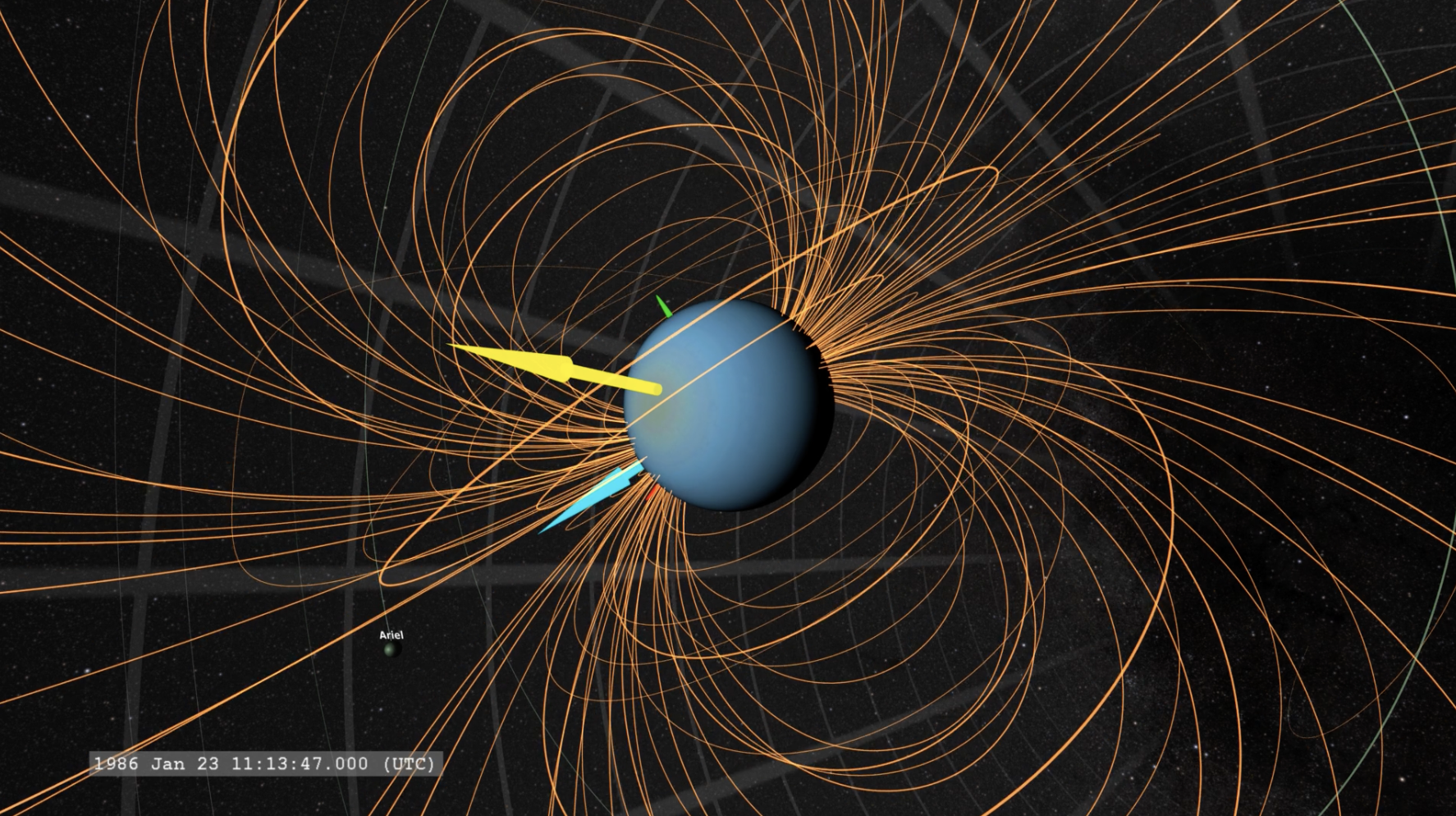
Key Properties
- Dipole Strength: ~0.23 Gauss at the equator (about 50× Earth’s field)
- Surface Field Range: 0.1–1.1 Gauss, highly variable
- Tilt: 58.6° from Uranus’ rotation axis (one of the most extreme in the Solar System)
- Offset: Magnetic field center is shifted ~0.31 Uranus radii southward
- Polarity: Same as Earth (a compass would point north)
Magnetospheric Structure
- Bow Shock: ~23 Uranus radii from the planet
- Magnetopause: ~18 Uranus radii on the Sun-facing side
- Magnetotail: Twisted “corkscrew” shape due to Uranus’ sideways rotation
- Particles: Mostly protons (H⁺) and electrons (e⁻) sourced from Uranus’ upper atmosphere
Aurora and Energetics
- Auroras: Not centered on the poles (unlike Earth/Jupiter) due to magnetic tilt
- Emissions: Dominated by molecular hydrogen bands (Lyman & Werner)
- Energy Source: Plasma precipitation from the magnetotail
Why Uranus’ Magnetosphere is Unique
- Most planets have magnetic fields aligned near their spin axes. Uranus’ extreme tilt plus its offset core creates a lopsided, rapidly changing magnetosphere.
- As Uranus rotates (every 17.2 hours), the magnetic field “wobbles” dramatically, causing complex interactions with the solar wind.
- This makes Uranus a natural laboratory for studying magnetospheres unlike those of Earth, Jupiter, or Saturn.
Current Research & Updates
- Voyager 2 flyby (1986): Only spacecraft to sample Uranus’ magnetic field directly.
- Hubble & ground-based studies (2000s–2025): Tracking auroras and solar wind interactions.
- Recent findings (2024): Uranus’ field may be less anomalous than first thought, with improved models showing partial symmetry in deeper layers.
6. Interior Structure
- Core: Rocky, ~0.55 Earth masses, ~5000 K
- Mantle: Hot, dense “ice” layer of H₂O, NH₃, CH₄ (superionic fluid)
- Atmosphere/Envelope: Outer 20% radius, H₂/He dominated
7. Extreme Seasons
- Day/Night at Poles: 42 years of sunlight, then 42 years of darkness
- Equinox Cycle: Every 42 years
- Current Season: Northern spring (since 2007)
8. Colors for Visualization
- Planet: Cyan-blue (#4FD0E7) with darker poles
- Rings: Dark gray to light gray, outer rings tinted reddish/blue
- Moons: Varying grays; Ariel brightest, Umbriel darkest
9. Simulation & Visualization Tips
- Exaggerate moon sizes (10–50×) and ring thickness (100–1000×) for visibility
- Scale time (1s = 1h to 1y) to show rotation, orbits, and seasons
- Prioritize accuracy: axial tilt, retrograde spin, methane colors, seasonal lighting
🔑 SEO Keywords Integrated: Uranus facts, Uranus atmosphere, Uranus moons, Uranus rings, Uranus magnetosphere, Uranus seasons, Uranus structure, Uranus simulation.
10. Scientific Data Sources
- NASA/JPL Voyager 2 mission data (1986)
- Hubble Space Telescope observations (2003-2025)
- Keck Observatory ring observations
- NASA Fact Sheets (NSSDC)
- IAU planetary nomenclature database
- Recent studies on magnetosphere (2024)
Updates and Corrections
- Latest magnetosphere understanding (2024): Field may be less anomalous than originally thought
- New tiny moon discovered (2023): S/2023 U1
- Ring temperature measurements (2019): ~77K
- Possible subsurface oceans in major moons
🌌 Uranus Resources & References
🔭 Mission Data & Space Agency Sources
- Voyager 2 Uranus Flyby (1986) — NASA Planetary Science Archive: Voyager Uranus Mission Overview
- NASA Planetary Fact Sheet: Uranus — Jet Propulsion Laboratory (JPL): NASA Uranus Fact Sheet (NSSDC)
- ESA Herschel & Hubble Uranus Studies: ESA Science & Technology: Uranus
- NASA Uranus Science Overview (rings, moons, atmosphere): Solar System Exploration – Uranus
🌍 Planetary Properties & Interior
- Guillot, T. (1999). Interior of Giant Planets Inside and Outside the Solar System. Annual Review of Earth and Planetary Sciences, 27: 411–444
- Helled, R., & Fortney, J. (2020). Uranus and Neptune: Origin, Evolution and Internal Structure. Philosophical Transactions of the Royal Society A
- Chemistry World | Mission to Uanrus
- NASA | Uranus Facts
☁️ Atmosphere & Climate
- Conrath, B. J., et al. (1987). Thermal structure and dynamics of Uranus’ atmosphere. Journal of Geophysical Research, 92(A13), 15003–15010
- Irwin, P. G. J., et al. (2018). Detection of hydrogen sulfide above the clouds of Uranus. Nature Astronomy 2: 420–424
- Molter, E. M., et al. (2020). Seasonal changes in Uranus’ atmosphere from Keck observations. The Astronomical Journal 160, 5
💍 Rings of Uranus
- Elliot, J. L., et al. (1977). The Rings of Uranus. Nature 267: 328–330
- de Pater, I., & Lissauer, J. J. (2015). Planetary Sciences (2nd ed.) — Chapter on Uranus’ rings.
- Showalter, M. R. (2019). Uranus Ring Temperatures from Keck Observatory. Icarus 329: 160–170
🌙 Moons of Uranus
- Smith, B. A., et al. (1986). Voyager 2 at Uranus: Imaging Science Results. Science 233, 43–64
- Schenk, P. M. (1991). Geology of Uranus’ Satellites: Geomorphic and Crater Analyses. Journal of Geophysical Research: Solid Earth, 96(E2): 1887–1906
- Cartwright, R. J., et al. (2020). Spectral evidence for oceans in Uranus’ moons Titania & Oberon. Icarus 338: 113446
- IAU Minor Planet Center — Uranian satellites naming & designations: IAU Moons of Uranus Database
🧲 Magnetosphere
- Ness, N. F., et al. (1986). Magnetic fields at Uranus. Science 233, 85–89
- Cao, H., & Stevenson, D. J. (2017). Dynamo models for Uranus and Neptune. Icarus 296, 59–72
- Lamy, L., et al. (2012). Auroral processes at Uranus: Hubble observations. Geophysical Research Letters 39, L07105
📊 Data Archives & Catalogs
- NASA Planetary Data System (PDS): Uranus mission and telescope data archive PDS Uranus Data
- International Astronomical Union (IAU) Working Group for Planetary System Nomenclature (WGPSN) Planetary Names: Uranus
🎨 Visualizations & Simulations
- NASA Scientific Visualization Studio — Uranus datasets: SVS: Uranus Visualizations
- Keck Observatory Uranus observations archive: Keck Data for Uranus
- Elliot’s Open Source Uranus Simulator (2025) Live Uranus Simulator on GitHub Pages Source Code Repository on GitHub
📰 News & Ongoing Research
- Chemistry World (2023). Mission to Uranus: Why the Ice Giant Deserves Exploration.
- Nature Astronomy (2023–2025) — New papers on Uranian moons & magnetosphere
- NASA & ESA proposals (2024–2025): Uranus Orbiter & Probe mission concepts for the 2030s
